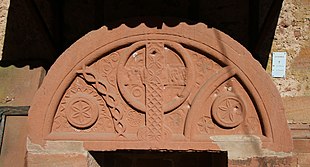Sturzelbronn Abbey
| Sturzelbronn Abbey | |
|---|---|
 portal |
|
| location |
Moselle department , Grand Est region of France |
| Lies in the diocese | Metz |
| Coordinates: | 49 ° 3 '27 " N , 7 ° 35' 12" E |
| Serial number according to Janauschek |
177 |
| founding year | 1135 |
| Year of dissolution / annulment |
1790 |
| Mother monastery | Maizières Monastery |
| Primary Abbey | La Ferté Monastery |
The Sturzelbronn Abbey ( German actually Stürzelbronn Abbey ; French abbaye de Sturzelbronn ) was a Cistercian abbey in Sturzelbronn ( German Stürzelbronn ) in the Moselle department in the Grand Est region (until 2015 Lorraine ) in the Northern Vosges , which existed from 1135 to 1790. Today there are still few building remains on site.
history
Duke Simon I of Lorraine (1127–1139) founded a Cistercian abbey in the woods east of Bitsch , on an old Roman road to Weissenburg , in 1135 with the permission of St. Bernard of Clairvaux and bequeathed large estates to it. The monks came from the Maizières monastery in Burgundy , a subsidiary of the La Ferté primary abbey . According to tradition, Bernhard von Clairvaux, who was greatly venerated by the ruling family of Lorraine, himself came to Stürzelbronn on December 27, 1146 on the old Roman road when he was on his way to the Second Crusade . This was largely due to his initiative. Simon's son, Matthew I (1139–1176), who succeeded Duke, expanded the monastery property considerably. Most of the old farm settlements in the east of the Zweibrück hill country can be traced back to Stürzelbronn ( Einöderwiesenhof, Stausteinerhof, etc. ). In the following centuries the dukes of Lorraine always acted as patrons of the monastery, even after it came to this territory in 1297 with the establishment of the County of Zweibrücken-Bitsch .
In a number of villages in the east of the Bitscherland , southeast of Zweibrücken and south of Pirmasens , the abbey was entitled to a tithe or at least a portion thereof. In 1525 the Peasants' War reached the area of the Counts of Zweibrücken-Bitsch and thus Stürzelbronn. The archive and the library were destroyed. The secular lord of the area, Count Reinhard, fled to the Duke of Lorraine. After the bloody suppression of the uprising and the death of 35,000 farmers in Lorraine and Alsace , the monks returned to Stürzelbronn.
When the Counts of Zweibrücken-Bitsch died out in 1570 and secular rule fell to the Protestant house of Hanau-Lichtenberg, Count Philipp V tried to take over the abbey and its goods. This led to the occupation of the entire county of Zweibrücken-Bitsch by Lorraine in 1572 and thus to the continued existence of the monastery.
During the Thirty Years' War in 1622, the marauding mercenaries of Ernst von Mansfeld plundered the area and thus also the monastery. Ten years later, Cardinal Richelieu called for the destruction of all of Lorraine. After Bitsch, the Stürzelbronn Abbey went up completely in flames in 1633, only the porter's house remained. It took until 1687 for monastery life to get going again. From 1711 a new monastery church was built and the monks sought to renew their old rights everywhere. So was with the Pirmasens resident Landgrave Ludwig IX. of Hesse in 1749 the boundary between spiritual and secular goods was precisely regulated by contract and marked out in the districts. Tithing lands were also marked with special stones bearing the letters GSZ in addition to the year and the national emblem . Even today, some of these boundary stones can be found in the districts of the villages of Vinningen , Obersimten , Eppenbrunn , Trulben , Schweix , Hilst and Kröppen , which are now part of the Pirmasens-Land association .
During the French Revolution , the Stürzelbronn Abbey and its possessions were declared national property on March 17, 1790. At that time only 9 monks were present. Hessen-Darmstadt seized the opportunity and also acquired the rights of the abbey that existed in this domain.
today
Only a few ruins still bear witness to the former importance of Stürzelbronn and the boundary stones with the abbot's staff that can still be found in many places in the Bitscher Land and the Zweibrücken hill country. The arched portal, which was declared a monument historique in 1987 , has been preserved.
Opposite the former abbey church, the Lothringer Verein für Altertumskunde has put up a plaque that provides detailed information about the lost building fabric. The most significant preserved element in terms of art history is a tympanum with esoteric ornaments, in which the Savior's Cross is surrounded by the sun, moon, stars, flowers and symbols of infinity. In the entrance area of the parish church is u. a. a perpetual calendar for calculating the Easter date is walled in.
In 1935 a statue of St. Bernhard set up.
The former inventory of the abbey was sold and auctioned after it was closed. In many churches in the area there are pieces of equipment from Stürzelbronn, the choir stalls in Louis-seize style are z. B. since 1804 in the former abbey church of Neuwiller-lès-Saverne .
literature
- Jean Baptiste Kaiser: The Stürzelbronn Abbey (= publications of the Alsace-Lorraine Scientific Society in Strasbourg. Series A: Alsatica and Lotharingica. Vol. 18, ZDB -ID 500485-8 ). Winter, Strasbourg, 1937.
- Henri Hiegel: Un monument historique en danger: l'ancienne abbaye cistericenne de Sturzelbronn. In: Les Cahiers lorrains. NS Vol. 17, No. 1, 1965, ISSN 0758-6760 , pp. 7-10.
